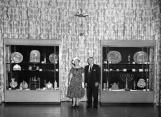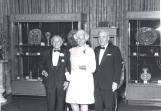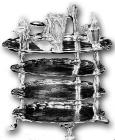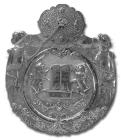1
Samuel Wechsler, Chairman and Collector2
The Aron Museum with its first Curator, Anna Aron, and Chairman Samuel Wechsler1960
Temple Emanu-El, Montreal, Quebec

3
By 1960, the collection of the Aron Museum had expanded to fill two display cases. Samuel Wechsler, who was a friend of the Arons and a strong supporter of the museum from its inception, filled the post of Chairman. This picture shows Anna Aron and Samuel Wechsler standing proudly in front of the museum's display cases.4
Samuel Wechsler was born in Russia before the turn of the nineteenth century. He immigrated to North America as a young man and settled in New York. He moved to Montreal in the 1920s in order to establish a Canadian branch of his business, Standard Sample Card. He and his wife Matilda joined Temple Emanu-El sometime toward the end of the 1930s. The Wechslers were very active in Temple life and contributed greatly to the community. Samuel Wechsler was one of the founders of the Aron Museum, along with Josef and Anna Aron.6
Samuel Wechsler's grandson, Michael Gertsman, remembers his grandfather's dedication to the museum in its early years: "He had a real passion for this museum project. He was friendly of course with Josef Aron, who was alive at the time, and between the two of them, they initiated the museum here at Temple. My grandfather took great delight in finding what he considered to be interesting and valuable pieces of Judaica, and building the museum at the Temple was a project that was very close to his heart."7
Mr. and Mrs. Samuel Wechsler and Rabbi Harry Stern at the Aron Museum. Late 1960sDate not available
Temple Emanu-El, Montreal, Quebec

8
Samuel and Josef were affiliated through their membership to Temple Emanu-El and had become close friends. Samuel's grandson describes the two men's relationship as a fraternal one based in their common passion and shared interest in collecting Jewish ceremonial art objects. They felt great pride as they built the museum and added pieces that the Aron Museum would be something unique to Temple Emanu-El. They were creating a legacy not only for the synagogue itself, but for the Jewish community as well as for the city, for those who would be interested beyond the boundaries of the Jewish community.10
The pieces donated to the Aron Museum by Mr. and Mrs. Samuel Wechsler are all unique and interesting works of art.One special container for storing spices for the Havdalah ceremony, which marks the end of Shabbat, was donated by Samuel Wechsler. The container takes the form of a fish. The head acts as a lid that can be detached from its body, and the spices are stored inside. The scales on the body are malleable, so that the entire fish moves with a remarkable sense of realism. The eyes of the fish are inlaid with rubies.
Michael Gertsman remembers that his grandfather was always on the lookout for pieces to add to the collection: "I think he had a number of sources in the United States and Canada. Some in New York, some in Chicago, and some in other places. I don't know how much he found in Canada. There may have been certain pieces that he got in from Israel. But he was always on the lookout for these pieces. That I remember about him. It was of great interest to him, so he was always looking for something special for the museum."
12
This seder plate, to be used for the Passover ceremony, was selected and donated by Samuel Wechsler. The top tray of this multi-tiered seder set holds six figurines representing slaves performing various building tasks. Each one holds a dish for one of the symbolic Passover foods. One of the figurines pushes a wheelbarrow in which one would put the "charoset," a mixture of apples, wine, walnuts and cinnamon that represent the mortar used by the Hebrew slaves in laying bricks. Over the course of the Passover ceremony, the story of Passover is recounted and all of the ritual foods are eaten.Michael Gertsman remembers the seder ceremonies that took place at his grandparents' home: "I especially remember the Passovers that we used to do at his house, where he would lead the Seder and of course he would want to do the whole service, and I remember my grandmother saying: 'Hurry up Sam, hurry up Sam, the dinner's ready.' And my poor grandfather would be forced to rush through the seder ceremony. I remember those times, they were wonderful."



